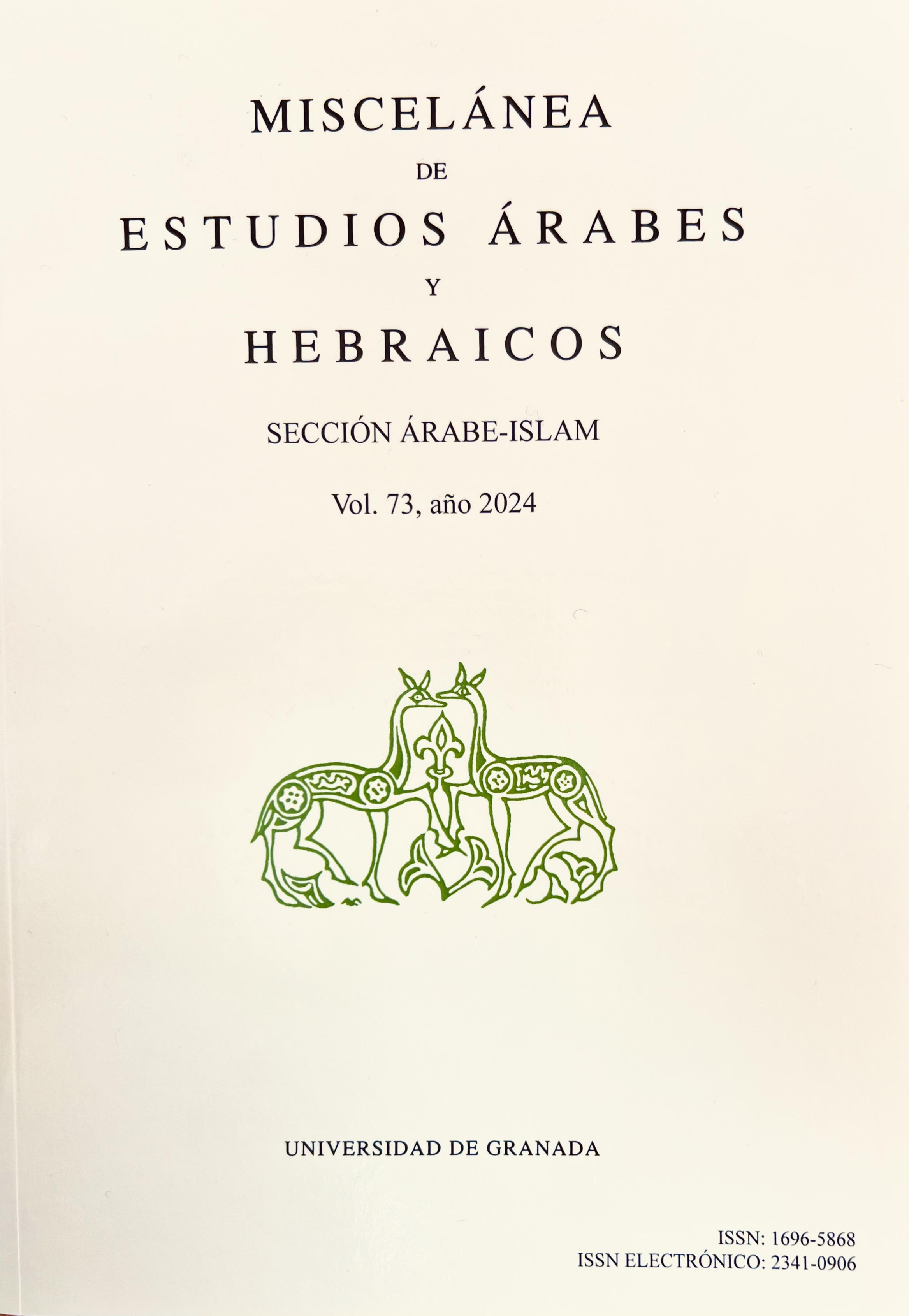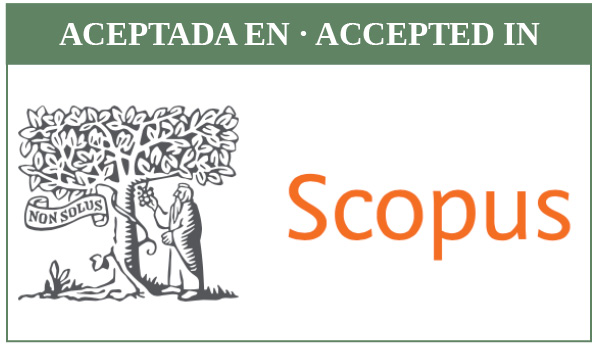Un episodio apócrifo atribuido al bardo preislámico Imruʼ al-Qays b. Ḥuŷr
DOI:
https://doi.org/10.30827/meaharabe.v73.28343Palabras clave:
Imruʼ al-Qays. Biografía. Fragmenta de Malko. Árabe. GriegoResumen
El objetivo del presente trabajo es analizar un episodio que está incluido en la obra del autor abasí Ibn al-Kalbī titulada Kitāb al-aṣnām, que es atribuido al célebre poeta preislámico Imruʼ al-Qays b. Ḥuŷr. Como consecuencia del carácter semi-legendario con que ha sido descrito el personaje en la literatura árabe, así como de los datos biográficos que sobre el mismo proporcionan las fuentes árabes, todo indica que el episodio contenido en el Kitāb al-aṣnām objeto de este trabajo es una invención más, tratándose por ello de un relato apócrifo, que fue atribuida al bardo dado el carácter pendenciero con el que el personaje es descrito en la tradición árabe. En apéndice ofrecemos la transcripción del texto griego, seguida de la versión castellana, de los Fragmenta de Malko Filadelfo, que incluye la información básica sobre el personaje original, un filarca siro-palestino, del que Imruʼ al-Qays b. Ḥuŷr parece ser su trasunto en opinión de algunos autores modernos.
Descargas
Citas
ABŪ L-FARAŶ AL-IṢFAHĀNĪ. Kitāb al-Agānī. Beirut: Dār Ṣaʻab, s.d. (ed. Būlāq), vol. VIII.
ʻALĪ, Ŷawād. Al-Mufaṣṣal fī taʼrīj al-ʻarab qabla l-islām. Beirut: Dār Iḥyāʼ al- Turāṯ al-ʻArabī, s.d.
ATALLAH, W. ‘Al-Kalbī’. En EI2, vol. IV, pp. 494-496.
BALDWIN, Barry. “Malchus of Philadelphia”. Dumbarton Oaks Papers, 31 (1977), pp. 91-107.
BLACHÈRE, Régis. Histoire de la littérature árabe des origines a la fin du XVe siècle de J.-C. 3 vols. París: Librairie d’Amérique et d’Orient Adrien- Maisonneuve, 1952, 1964, 1966.
BOUSTANY, S. “Imruʼ al-Ḳays b. Ḥudjr”. En EI2, vol. III, p. 1206. BROCKELMANN, Carl. Geschichte der arabischen Litteratur (GAL). Weimar -Berlín: E. Felber, 1898, 1902.
AL-BUSTĀNĪ, Buṭrus. Udabāʼ al-ʻarab fī l-ŷāhiliyya wa-ṣadr al-islām. Beirut: Dār Mārūn ʻAbbūd, 1979.
ḌAYF, Šawqī. Al-ʻAṣr al-ŷāhilī. El Cairo: Dār al-Maʻārif, 200324.
AL-FĀJŪRĪ, Ḥannā. Taʼrīj al-adab al-ʻarabi. Beirut: al-Maṭbaʻa al-Būlusiyya, s.d.
GIBB, Hamilton A. R. Arabic Literature: An Introduction. Oxford: Clarendon Press, 19662.
HENGSTENBERG, Ernst G. Amrulkeisi Moallakah. Cum scholiis Zuzenii e co- dicibus parisiensis, edidit latine vertit et illustravit. Bonn: Typis Regis in Offi- cina Thormanniana, 1823.
HOYLAND, Robert G. Arabia and the Arabs: From the Bronze Age to the co- ming of Islam. Londres – Nueva York: Routledge, 2002.
ḤUSAYN, Ṭāhā. Fī l-šiʻr al-ŷāhilī. El Cairo: Maṭbaʻat Fārūq, 1352/19333.
IBN AL-KALBĪ. Kitāb al-aṣnām. Ed. Muḥammad ʼAbd al-Qādir Aḥmad y Aḥmad Unḥammad ʼUbayd. El Cairo: Maktabat al-Nahḍa al-Miṣriyya, 1993.
KAḤḤĀLA, ʻUmar Riḍā. Muʻŷam al-muʼallifīn. Tarāŷim muṣannifī l-kutub al- ʻarabiyya. Damasco: Maṭbaʻat al-Taraqqī, 1376-81 H/1957-61 d.C.
KAWAR (SHAHÎD), Irfan. “The Patriciate of Imruʼ al-Qays’. En James KRITZEEK y R. BAYLY (eds.). The World of Islam. Studies in Honor of Philip K. Hitti. Nueva York: MacMillan, 1959, pp. 74-76 (reimp. SHAHÎD, Irfan. Byzantium and the Arabs. Late Antiquity III. (Bibliotheque de Byzan- tion 9, Série des Réimpressions 3). Bruselas: Byzantion, 2006, pp. 1-9).
MALKO FILADELFO. “Malchi Philadelphensis fragmenta”. En Karl MÜLLER (ed.). Fragmenta historicorum græcorum. Collegit, disposuit, notis et prole- gominis illustravit. París: Firmin Didot, 1851, vol. IV, pp. 112-113.
MAYERSON, Philip. “The Island of Iotabê in the Byzantine Sources: A Repri- se”. Bulletin of the American Schools of Oriental Research, 287 (1992), pp. 1- 4.
MUNT, Harry et al. “Arabic and Persian Sources for Pre-Islamic Arabia”. En Greg FISHER (ed.). Arabs and Empires before Islam. Oxford: Oxford Uni- versity Press, 2015, pp. 434-500.
NICHOLSON, Reynold A. A Literary History of the Arabs. Londres: T. Fisher Unwin, 1907.
NÖLDEKE, Theodor. Geschichte der Perser un Araber zur Zeit der Sasaniden. Aus der arabischen Chronik de Tabari. Leiden: E.J. Brill, 1879.
ROTHSTEIN, Gustav. Die Dynastie der Laḫmiden in al-Ḥîra. Ein Versuch zur arabisch-persischen Geschichte zur Zeit der Sasaniden. Berlin: Reuther & Reichard, 1899.
AL-SANDŪBĪ, Ḥasan. Šarḥ Dīwān Imruʼ al-Qays wa-maʻa-hu Ajbār al- murāqisa wa-ašʻāri-him fī l-ŷāhiliyya wa-ṣadr al-islām wa-yalīhi Ajbār al- nawābig wa-aṯāri-him fī l-ŷāhiliyya wa-ṣadr al-islām. Beirut: al-Maktaba al- Ṯaqāfiyya, 1402/19827.
SEZGIN, Fuat. Geschichte des arabischen Schrifttums. Band II: Poesie bis ca. 430 H. Leiden: E.J. Brill. 1975.
SHAHÎD, Irfan. Byzantium and the Arabs in the Fifth Century. Washinton D.C.: Dumbarton Oaks, 2006, reimp. de la ed. de 1989.
SOBH, Mahmud. Historia de la literatura árabe clásica. Madrid: Cátedra, 2002. TORAL-NIEHOFF, Isabel. Al-Ḥīra: Eine arabische Kulturmetropole im spätan-tiken Kontext. Leiden – Boston: Brill, 2014.
AL-ZIRIKLĪ, Jayr al-Dīn. Al-Iʻlām. Qāmūs tarāŷim li-ašhar al-riŷāl wa-l-nisāʼ min al-ʻarab wa-l-mustaʻribīn wa-l-mustašriqīn. Beirut: Dār al-ʻIlm li-l- Malāyīn, 199610.
Descargas
Publicado
Cómo citar
Número
Sección
Licencia
Los autores que publican en esta revista están de acuerdo con los siguientes términos:
1. Los autores conservan los derechos de autor y garantizan a la revista el derecho de ser la primera publicación del trabajo al igual que licenciado bajo una Creative Commons Attribution License que permite a otros compartir el trabajo con un reconocimiento de la autoría del trabajo y la publicación inicial en esta revista.
2. Los autores pueden establecer por separado acuerdos adicionales para la distribución no exclusiva de la versión de la obra publicada en la revista (por ejemplo, situarlo en un repositorio institucional o publicarlo en un libro), con un reconocimiento de su publicación inicial en esta revista.
3. Se permite y se anima a los autores a difundir electrónicamente (por ejemplo, en repositorios institucionales o en su propio sitio web) la versión publicada de sus trabajos (versión post-print del editor) o, en su defecto, el de la versión post-print del autor ya evaluada y aceptada. Esto puede dar lugar a intercambios productivos, así como a una citación más temprana y mayor de los trabajos publicados (Véase The Effect of Open Access).
4. La revista no se hace responsable de las opiniones vertidas por los autores.















